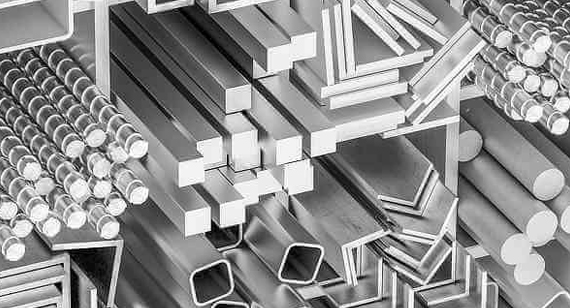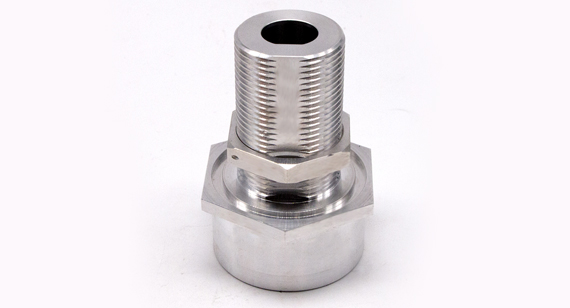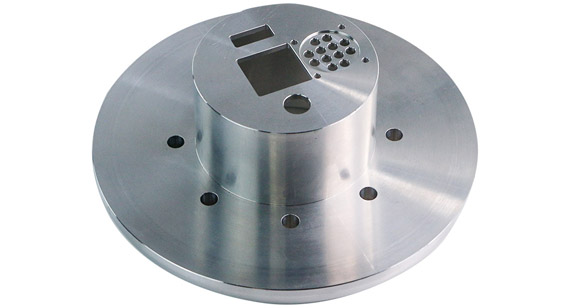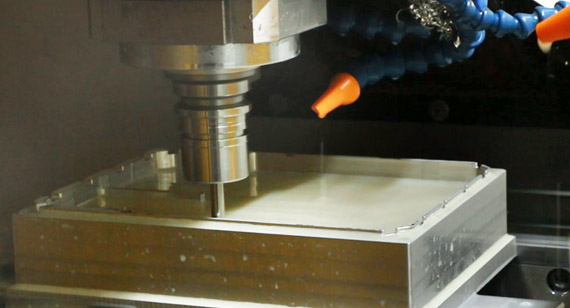15 years one-stop China custom CNC machining parts factory
 1515 |
Published by VMT at Nov 20 2024 | Reading Time:About 6 minutes
1515 |
Published by VMT at Nov 20 2024 | Reading Time:About 6 minutes
Are you searching for a material that combines exceptional strength, fatigue resistance, and excellent machinability for your next high-performance project? Frustrated by alloys that either fall short in mechanical properties or pose challenges during processing in your CNC machining operations? You're not alone. Many engineers and manufacturers grapple with finding the ideal material that meets stringent performance requirements while remaining cost-effective and adaptable to various manufacturing methods. But what if 2024 aluminum alloy could be the solution you're seeking—offering a superior strength-to-weight ratio and compatibility with custom CNC machining processes to elevate your projects to the next level?
2024 aluminum alloy is a high-strength material primarily composed of aluminum, copper, magnesium, and manganese. Renowned for its excellent fatigue resistance and high strength-to-weight ratio, it's ideal for aerospace structures, automotive components, and other demanding applications where performance and weight are critical factors.
Now that we've introduced 2024 aluminum alloy as a potential game-changer for your engineering and manufacturing needs, let's delve deeper into its unique characteristics, alloy composition, properties, and how it can be effectively processed using various manufacturing methods, including CNC machining services. Understanding these aspects will empower you to make informed decisions for your next project.
Preface
In the competitive world of materials engineering, aluminum alloys stand out for their versatility, lightweight nature, and remarkable mechanical properties. Among these, 2024 aluminum alloy has carved a niche for itself, especially in industries that demand materials capable of withstanding high stress and strain. As sectors like aerospace and automotive push the boundaries of performance, the importance of selecting the right material becomes paramount. This comprehensive guide aims to provide an in-depth understanding of 2024 aluminum alloy, covering its characteristics, applications, and processing methods, particularly in the context of CNC machining services.
Aluminum alloys are materials where aluminum is the predominant metal, combined with various other elements to enhance specific properties like strength, corrosion resistance, and machinability. Pure aluminum, while lightweight and corrosion-resistant, lacks sufficient strength for most structural applications. By alloying it with elements such as copper, magnesium, silicon, and zinc, engineers can tailor its properties to meet a wide range of application requirements.
These alloys are categorized into series based on their primary alloying elements. For instance:
1xxx Series: Pure aluminum (99% or higher)
2xxx Series: Copper as the main alloying element
5xxx Series: Magnesium as the main alloying element
6xxx Series: Magnesium and silicon as principal alloying elements
7xxx Series: Zinc as the primary alloying element
Each series offers unique characteristics, making aluminum alloys suitable for applications ranging from household appliances to critical aerospace components.

2024 aluminum alloy is part of the 2xxx series, where copper is the principal alloying element. Developed in the early 20th century, 2024 aluminum quickly became a staple in the aerospace industry due to its exceptional mechanical properties. It's recognized for its high strength, excellent fatigue resistance, and good machinability, making it ideal for components that must endure high stress over prolonged periods.
The unique properties of 2024 aluminum alloy stem from its specific chemical composition. Below is a table outlining the typical alloying elements and their percentage composition:
| Element |
Percentage Composition (%) |
| Aluminum (Al) | Balance (approx. 90.7 - 94.7) |
| Copper (Cu) | 3.8 - 4.9 |
| Magnesium (Mg) | 1.2 - 1.8 |
| Manganese (Mn) | 0.3 - 0.9 |
| Iron (Fe) | Max 0.5 |
| Silicon (Si) | Max 0.5 |
| Zinc (Zn) | Max 0.25 |
| Chromium (Cr) | Max 0.1 |
| Titanium (Ti) | Max 0.15 |
| Other elements (each) | Max 0.05 |
| Other elements (total) | Max 0.15 |
Copper (Cu): Enhances strength and hardness.
Magnesium (Mg): Improves strength and hardness, especially after heat treatment.
Manganese (Mn): Increases strength and resistance to corrosion.
Iron (Fe) and Silicon (Si): Present as impurities but can influence mechanical properties.
This specific blend of elements results in an alloy that offers a remarkable combination of strength, lightness, and durability, making it a preferred choice in high-performance industries.

Understanding the properties of 2024 aluminum alloy is crucial for determining its suitability for specific applications and processing methods. Its properties can be broadly categorized into physical and mechanical properties, each playing a significant role in its performance.
Physical Properties
The physical properties of 2024 aluminum alloy influence its behavior during manufacturing and in-service performance. Key physical properties include density, thermal conductivity, electrical conductivity, coefficient of thermal expansion, and machinability.
Density
2024 aluminum alloy has a density of approximately 2.78 g/cm³ (0.100 lb/in³). This low density is one of the primary reasons aluminum alloys are favored in applications where weight reduction is critical, such as in aerospace and automotive industries. The high strength-to-weight ratio of 2024 aluminum makes it ideal for structural components that must be both strong and lightweight.
Thermal Conductivity
The thermal conductivity of 2024 aluminum is about 121 W/m·K. This relatively high thermal conductivity allows for efficient heat dissipation, beneficial in applications involving heat exchange or where thermal management is crucial, like in electronic enclosures or heat sinks.
Electrical Conductivity
2024 aluminum alloy has an electrical conductivity of approximately 30% IACS (International Annealed Copper Standard). While not as conductive as pure aluminum or some other alloys, this level is adequate for many applications, including electrical components where mechanical strength is more critical than maximum conductivity.
Coefficient of Thermal Expansion (CTE)
The coefficient of thermal expansion for 2024 aluminum is about 23.2 µm/m·°C. This means the material expands 23.2 micrometers per meter for every degree Celsius increase in temperature. Understanding the CTE is essential for applications involving temperature fluctuations to ensure dimensional stability.
Machinability
2024 aluminum alloy is renowned for its excellent machinability, making it a preferred material for CNC machining parts. Its machinability rating is approximately 70%, with free-cutting brass rated at 100% for comparison. This property is particularly advantageous in custom CNC machining, where precision and efficiency are paramount.
| Physical Property |
2024-T3 |
2024-T4 |
2024-T851 |
| Density |
2.78 g/cm3 |
2.78 g/cm3 |
2.78 g/cm3 |
| Solidus |
502 °C |
502 °C |
502 °C |
| Liquidus |
638 °C |
638 °C |
638 °C |
| Annealing temperature |
413 °C |
413 °C |
413 °C |
| Thermal conductivity |
121 W/mK |
121 W/mK |
151 W/mK |
| Specific heat capacity |
0.875 KJ/Kg°C |
0.875 KJ/Kg°C |
0.875 KJ/Kg°C |
| Thermal conductivity |
121 W/mK |
121 W/mK |
151 W/mK |
Mechanical Properties
The mechanical properties of 2024 aluminum alloy, such as tensile strength, yield strength, hardness, fatigue strength, and shear strength, are what truly set it apart, especially for high-stress applications.
Tensile Strength
Ultimate Tensile Strength: Approximately 470 MPa (68,000 psi) in the T3 temper.
Significance: Indicates the maximum stress the material can withstand while being stretched before breaking. High tensile strength makes it suitable for structural applications requiring robust materials.
Yield Strength
Yield Strength: About 325 MPa (47,000 psi) in the T3 temper.
Significance: The stress at which the material begins to deform plastically. A high yield strength ensures components maintain their shape under load.
Hardness
Hardness (Brinell Hardness Number): Approximately 120 HB in the T3 temper.
Significance: Reflects resistance to indentation and wear, contributing to the material's durability.
Fatigue Strength
Fatigue Strength: Around 138 MPa (20,000 psi) for 500 million cycles.
Significance: Essential for components subjected to cyclic loading, such as aircraft wings and fuselage structures.
Shear Strength
Shear Strength: Approximately 285 MPa (41,000 psi).
Significance: Critical for components like rivets and bolts where shear forces are predominant.
Below is a summary chart of 2024 aluminum properties, which vary according to common heat treatment processes:
| Mechanical Property |
2024-T3 |
2024-T4 | 2024-T851 |
| Tensile strength | 483 MPa | 469 MPa | Above 455 MPa |
| Yield strength | 345 MPa | 324 MPa | Above 400 MPa |
| Modulus of elasticity | 73.1 GPa | 73.1 GPa | 72.4 GPa |
| Brinell hardness – 500g weight, 10 mm ball | 120 | 120 | 128 |
| Elongation at break (12.7 mm test piece) | 0.18 | 0.19 | 0.05 |
| Shear strength | 283 GPa | 283 GPa | 296 GPa |
| Fatigue strength | 138 MPa |
138 MPa |
117 MPa |
| Thermal expansion coefficient | 23.2 µm/m°C | 23.2 µm/m°C | 23.2 µm/m°C |
Note: Values are approximate and can vary based on specific processing conditions.

Corrosion resistance is a vital consideration, especially in applications exposed to harsh environments. While 2024 aluminum alloy offers exceptional mechanical properties, it has moderate corrosion resistance compared to other aluminum alloys.
General Corrosion Resistance
2024 aluminum is susceptible to corrosion in moist environments, particularly when in contact with dissimilar metals, leading to galvanic corrosion. The presence of copper, while enhancing strength, reduces its overall corrosion resistance.
Stress Corrosion Cracking (SCC)
Stress corrosion cracking is a significant concern with 2024 aluminum, especially in the T3 and T4 tempers. SCC can lead to sudden and catastrophic failure, making it essential to consider protective coatings or alternative materials in environments prone to inducing SCC.
Pitting
Pitting corrosion can occur when 2024 aluminum is exposed to chloride ions, such as those found in saltwater environments. Pitting leads to localized holes or cavities, which can compromise structural integrity over time.
Comparing 2024 aluminum alloy to other alloys helps in selecting the right material for specific environmental conditions and performance requirements.
6061 Aluminum Alloy
Corrosion Resistance: Better than 2024 aluminum due to its silicon and magnesium composition.
Applications: Used in marine environments, structural components, and where welding is required.
CNC Machining: Excellent machinability makes it popular in CNC machining factories.
5052 Aluminum Alloy
Corrosion Resistance: Superior corrosion resistance, especially in marine environments.
Applications: Ideal for fuel tanks, marine equipment, and chemical containers.
CNC Machining: Good formability and machinability for CNC prototype machining.
7075 Aluminum Alloy
Corrosion Resistance: Similar to 2024, with moderate resistance.
Applications: High-strength applications like aircraft structures and military equipment.
CNC Machining: Requires precision machining due to its strength.
Processing methods significantly impact the properties and performance of 2024 aluminum alloy. Key processes include casting, heat treatment, cold working, machining, and welding.
Alloys and Casting
Casting: 2024 aluminum can be cast but is more commonly available as wrought products like sheets, plates, and extrusions.
Challenges: Casting can lead to segregation of alloying elements, affecting mechanical properties.
Heat Treatment
Heat treatment alters the microstructure to enhance mechanical properties. Common tempers include:
2024-T3
Process: Solution heat-treated, cold-worked, and naturally aged.
Properties: High strength with good fatigue resistance.
2024-T4
Process: Solution heat-treated and naturally aged.
Properties: Good formability with moderate strength.
2024-T6
Process: Solution heat-treated and artificially aged.
Properties: Increased strength but reduced ductility.
2024-O
Process: Annealed.
Properties: Maximum ductility with lowest strength, suitable for complex forming.
Effects of Heat Treatment on 2024-T4 and 2024-T3
2024-T4: Offers a balance between strength and formability.
2024-T3: Higher strength due to cold working but less formable than T4.
Cold Working and Machining
Cold Working: Increases strength through strain hardening.
Machining: Excellent machinability makes it suitable for CNC machining services, allowing for precise and efficient production of complex parts.
Welding
Weldability: Generally poor due to susceptibility to hot cracking and loss of mechanical properties.
Alternatives: Mechanical fastening or using alloys with better weldability for welded assemblies.

The compatibility of 2024 aluminum alloy with CNC machining processes makes it a popular choice for producing high-precision components.
High Precision and Accuracy
Benefits: Ability to achieve tight tolerances and complex geometries.
Applications: Ideal for aerospace components, precision instruments, and structural parts.
Anodizing: Enhances corrosion resistance and surface hardness.
Cladding: Applying a thin layer of pure aluminum to improve corrosion resistance.
Versatility
Product Forms: Available in sheets, plates, bars, and extrusions.
Custom CNC Machining: Allows for tailored solutions to specific project requirements.
Automation
Efficiency: CNC automation leads to consistent quality and reduced production times.
CNC Machining Factory: Facilities equipped with advanced CNC machines can handle large production volumes efficiently.

When compared to other alloys, 2024 aluminum offers several distinct advantages.
High Strength-to-Weight Ratio
Benefit: Provides significant strength without adding excessive weight.
Impact: Essential for aerospace and automotive industries where performance and fuel efficiency are critical.
Good Fatigue Resistance
Benefit: Withstands cyclic stresses over prolonged periods.
Impact: Increases the lifespan of components subjected to repeated loading.
Machinability
Benefit: Facilitates efficient and precise machining.
Impact: Reduces manufacturing costs and time, especially in CNC machining parts production.
Despite its advantages, 2024 aluminum alloy has certain limitations.
Susceptibility to Stress Corrosion Cracking
Challenge: Requires protective measures like coatings or cladding.
Solution: Use in environments less prone to induce SCC or select alternative materials.
Low Weldability
Challenge: Welding can lead to hot cracking and weakened joints.
Solution: Opt for mechanical fastening methods or use welding techniques designed for aluminum.
Limited Formability
Challenge: Not as formable as other alloys like 5052.
Solution: Use the O temper for forming operations, then heat-treat to desired temper.
The unique properties of 2024 aluminum alloy make it suitable for various high-performance applications.
Aerospace Industry
Usage: Aircraft structures, fuselage frames, wing skins, and rivets.
Reason: High strength-to-weight ratio and fatigue resistance.
Usage: High-performance parts like gears and shafts.
Reason: Enhances vehicle performance and fuel efficiency.
Sports Equipment
Usage: Bicycle frames, climbing gear, and other equipment requiring durability and lightness.
Reason: Combines strength with lightweight characteristics.
Marine Applications
Usage: Boat structures and fittings (with proper corrosion protection).
Reason: Strength benefits outweigh corrosion concerns when adequately protected.
2024 aluminum alloy stands as a testament to the remarkable capabilities of aluminum alloys. Its exceptional strength, fatigue resistance, and machinability make it a material of choice for demanding applications in aerospace, automotive, and other high-performance industries. While it does have limitations, such as susceptibility to corrosion and welding challenges, these can be managed with proper processing and protective measures.
For manufacturers and engineers leveraging CNC machining services, 2024 aluminum offers the precision, efficiency, and versatility needed to produce high-quality, reliable components. By understanding its characteristics, applications, and processing methods, professionals can make informed decisions, ensuring their projects meet performance expectations while optimizing costs.
Where Is 2024 Aluminum Alloy Used?
2024 aluminum alloy is predominantly used in the aerospace industry for aircraft structures, including fuselage frames and wing skins, due to its high strength and fatigue resistance. It's also utilized in automotive components, sports equipment, and high-performance applications where strength-to-weight ratio is critical.
Is 2024 Aluminum Stronger Than 6061 Aluminum?
Yes, 2024 aluminum is generally stronger than 6061 aluminum. It has higher tensile and yield strengths, making it more suitable for applications requiring superior mechanical performance. However, 6061 offers better corrosion resistance and weldability.
What Is the Operating Temperature Range of 2024 Aluminum?
2024 aluminum alloy maintains its mechanical properties within an operating temperature range of approximately -196°C to 125°C (-320°F to 257°F). Beyond this range, its mechanical properties may degrade.
Is 2024 Aluminum Suitable for Welding?
2024 aluminum is generally not recommended for welding due to its susceptibility to hot cracking and loss of mechanical properties in the welded area. If welding is necessary, specialized techniques and filler materials must be used, and post-weld heat treatment may be required.
How Strong Is 2024 Aluminum?
In the T3 temper, 2024 aluminum has an ultimate tensile strength of about 470 MPa (68,000 psi) and a yield strength of approximately 325 MPa (47,000 psi), making it one of the strongest aluminum alloys available.
What Are the Common Trade Names for 2024 Aluminum?
Common trade names include ALCLAD 2024, referring to 2024 aluminum sheet clad with pure aluminum for improved corrosion resistance. It's also known simply as 2024-T3 or 2024-T4, indicating its temper.
What Is Aviation Grade Aluminum 2024?
Aviation grade 2024 aluminum refers to the high-quality 2024 alloy used in the aerospace industry, meeting stringent standards for mechanical properties and consistency. It's specifically formulated for aircraft structural applications.
What Is the Difference Between 2014 Aluminum and 2024 Aluminum?
While both are high-strength, copper-based aluminum alloys, 2024 aluminum generally offers better fatigue resistance and machinability compared to 2014 aluminum, which has higher silicon content and slightly different mechanical properties.
What Is the Cheapest Aluminum Alloy?
The 1xxx series, such as 1100 aluminum, is often the cheapest due to its high aluminum content and minimal alloying elements. It's used where high strength is not required.
What Is the Lightest Aluminum Alloy?
All aluminum alloys have similar densities, but those with lithium additions, like 2195 aluminum, are lighter. However, 2024 aluminum is still considered lightweight compared to other metals.
What Is the Weakest Aluminum Alloy?
Pure aluminum alloys in the 1xxx series, like 1100 aluminum, are among the weakest in terms of mechanical strength but offer excellent corrosion resistance and formability.
By comprehensively understanding 2024 aluminum alloy—from its alloy composition and properties to its processing methods and applications—you can harness its strengths while effectively navigating its limitations. Whether you're involved in CNC machining parts, custom CNC machining, or seeking reliable CNC machining services, 2024 aluminum offers a robust solution for high-performance demands.
